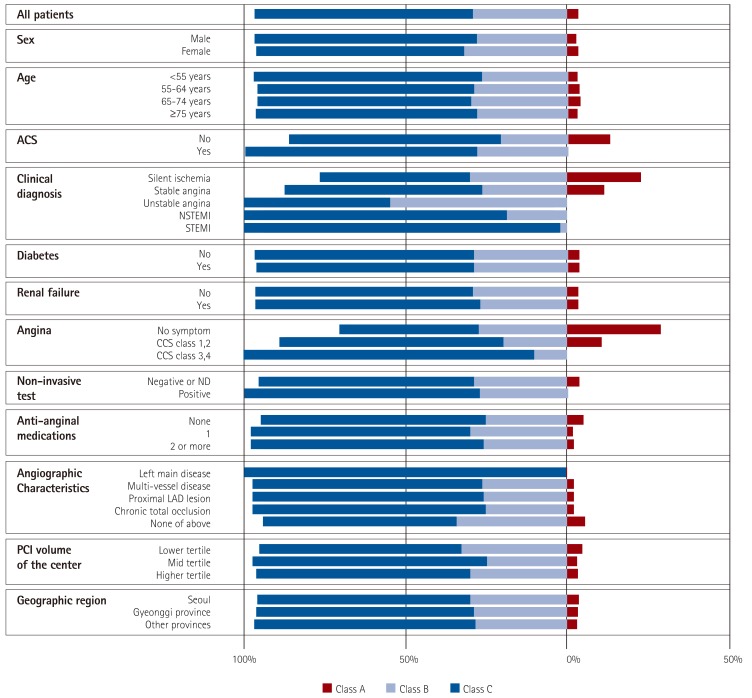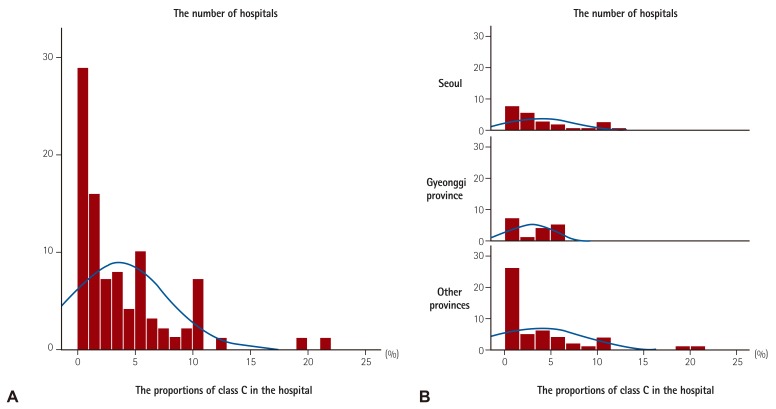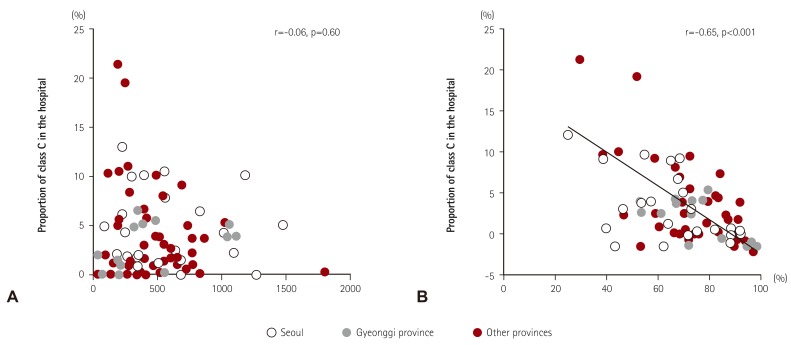The Practice Pattern of Percutaneous Coronary Intervention in Korea: Based on Year 2014 Cohort of Korean Percutaneous Coronary Intervention (K-PCI) Registry
- Affiliations
-
- 1Heart Vascular and Stroke Institute, Samsung Medical Center, Sungkyunkwan University School of Medicine, Seoul, Korea.
- 2Division of Cardiology, National Health Insurance Service Ilsan Hospital, Goyang, Korea. jdw121620@naver.com
- 3Department of Internal Medicine, Seoul National University Hospital, Seoul, Korea.
- 4Division of Cardiology, Busan Paik Hospital, University of Inje College of Medicine, Busan, Korea.
- 5Division of Cardiology, Asan Medical Center, University of Ulsan College of Medicine, Seoul, Korea.
- 6Division of Cardiology, Severance Cardiovascular Hospital, Yonsei University College of Medicine, Seoul, Korea.
- 7Division of Cardiology, St. Vincent's Hospital, College of Medicine, The Catholic University of Korea, Suwon, Korea.
- 8Division of Cardiology, Heart Center of Chonnam National University Hospital, Gwangju, Korea.
- 9Department of Internal Medicine, Chungbuk National University College of Medicine, Cheongju, Korea.
- 10Division of Cardiology, Keimyung University Dongsan Medical Center, Daegu, Korea.
- 11Division of Cardiology, Sanggye-Paik Hospital, University of Inje College of Medicine, Seoul, Korea.
- 12Department of Internal Medicine, Kangdong Sacred Heart Hospital, Hallym University Medical Center, Seoul, Korea.
- KMID: 2385386
- DOI: http://doi.org/10.4070/kcj.2017.0070
Abstract
- BACKGROUND AND OBJECTIVES
Appropriate use criteria (AUC) was developed to improve the quality of percutaneous coronary intervention (PCI). However, these criteria should consider the current practice pattern in the country where they are being applied.
MATERIALS AND METHODS
The algorithm for the Korean PCI practice pattern (KP3) was developed by modifying the United States-derived AUC in expert consensus meetings. KP3 class A was defined as any strategy with evidence from randomized trials that was more conservative for PCI than medical therapy or coronary artery bypass graft (CABG). Class C was defined as any strategy with less evidence from randomized trials and more aggressive for PCI than medical therapy or CABG. Class B was defined as a strategy that was partly class A and partly class C. We applied the KP3 classification system to the Korean PCI registry.
RESULTS
The KP3 class A was noted in 67.7% of patients, class B in 28.8%, and class C in 3.5%. The median proportion of class C cases per center was 2.0%. The distribution of KP3 classes varied significantly depending on clinical and angiographic characteristics. The proportion of KP3 class C cases per center was not significantly dependent on PCI volume, but rather on the percentage of ACS cases in each center.
CONCLUSION
We report the current PCI practice pattern by applying the new KP3 classification in a nationwide PCI registry. The results should be interpreted carefully with due regard for the complex relationships between the determining variables and the healthcare system in Korea.
MeSH Terms
Figure
Cited by 4 articles
-
Dose Coronary Angiography Suffice for Assessment of Intermediate Coronary Stenosis?
Sung Gyun Ahn, Sang Jun Lee
Korean Circ J. 2019;49(11):1033-1034. doi: 10.4070/kcj.2019.0227.The Current Status of Intervention for Intermediate Coronary Stenosis in the Korean Percutaneous Coronary Intervention (K-PCI) Registry
Jin-Ho Kim, Woonggil Choi, Ki-Chang Kim, Chang-Wook Nam, Bum-Kee Hong, June-Hong Kim, Doo Soo Jeon, Jang-Whan Bae, Sang-Hyun Kim, Keon-Woong Moon, Byung-Ryul Cho, Doo Il Kim, Jae-Sik Jang
Korean Circ J. 2019;49(11):1022-1032. doi: 10.4070/kcj.2019.0074.The Current Status of Percutaneous Coronary Intervention in Korea: Based on Year 2014 & 2016 Cohort of Korean Percutaneous Coronary Intervention (K-PCI) Registry
Dong-Ho Shin, Hyun-Jae Kang, Jae-Sik Jang, Keon-Woong Moon, Young Bin Song, Duk-Woo Park, Jang-Whan Bae, Juhan Kim, Seung-Ho Hur, Byung Ok Kim, Dong Woon Jeon, Donghoon Choi, Kyoo-Rok Han
Korean Circ J. 2019;49(12):1136-1151. doi: 10.4070/kcj.2018.0413.Diffuse Long Coronary Artery Disease is Still an Obstacle for Percutaneous Coronary Intervention in the Second-Generation Drug-Eluting Stent Era?
Pyung Chun Oh, Seung Hwan Han
Korean Circ J. 2019;49(8):721-723. doi: 10.4070/kcj.2019.0150.
Reference
-
1. Patel MR, Dehmer GJ, Hirshfeld JW, et al. ACCF/SCAI/STS/AATS/AHA/ASNC 2009 appropriateness criteria for coronary revascularization: a report by the American college of cardiology foundation appropriateness criteria task force, society for cardiovascular angiography and interventions, society of thoracic surgeons, American association for thoracic surgery, American heart association, and the American society of nuclear cardiology endorsed by the American society of echocardiography, the heart failure society of America, and the society of cardiovascular computed tomography. J Am Coll Cardiol. 2009; 53:530–553. PMID: 19195618.2. Patel MR, Dehmer GJ, Hirshfeld JW, et al. ACCF/SCAI/STS/AATS/AHA/ASNC/HFSA/SCCT 2012 appropriate use criteria for coronary revascularization focused update: a report of the American college of cardiology foundation appropriate use criteria task force, society for cardiovascular angiography and interventions, society of thoracic surgeons, American association for thoracic surgery, American heart association, American society of nuclear cardiology, and the society of cardiovascular computed tomography. J Am Coll Cardiol. 2012; 59:857–881. PMID: 22296741.3. Patel MR, Calhoon JH, Dehmer GJ, et al. ACC/AATS/AHA/ASE/ASNC/SCAI/SCCT/STS 2016 appropriate use criteria for coronary revascularization in patients with ACSs: a report of the American college of cardiology appropriate use criteria task force, American association for thoracic surgery, American heart association, American society of echocardiography, American society of nuclear cardiology, society for cardiovascular angiography and interventions, society of cardiovascular computed tomography, and the society of thoracic surgeons. J Am Coll Cardiol. 2017; 69:570–591. PMID: 28012615.4. Desai NR, Bradley SM, Parzynski CS, et al. Appropriate use criteria for coronary revascularization and trends in utilization, patient selection, and appropriateness of percutaneous coronary intervention. JAMA. 2015; 314:2045–2053. PMID: 26551163.5. Committee for the Korean guidelines for the management of dyslipidemia. 2015 Korean guidelines for the management of dyslipidemia: executive summary (English translation). Korean Circ J. 2016; 46:275–306. PMID: 27275165.6. Wayangankar SA, Bangalore S, McCoy LA, et al. Temporal trends and outcomes of patients undergoing percutaneous coronary interventions for cardiogenic shock in the setting of acute myocardial infarction: a report from the CathPCI Registry. JACC Cardiovasc Interv. 2016; 9:341–351. PMID: 26803418.7. Brindis RG, Fitzgerald S, Anderson HV, et al. The American college of cardiology-national cardiovascular data registry (ACC-NCDR): building a national clinical data repository. J Am Coll Cardiol. 2001; 37:2240–2245. PMID: 11419906.8. Jernberg T, Attebring MF, Hambraeus K, Shaw RE, Weintraub WS, Williams JF. The Swedish web-system for enhancement and development of evidence-based care in heart disease evaluated according to recommended therapies (SWEDEHEART). Heart. 2010; 96:1617–1621. PMID: 20801780.9. García del Blanco B, Hernández Hernández F, Rumoroso Cuevas JR, et al. Spanish cardiac catheterization and coronary intervention registry. 23rd Official report of the Spanish society of cardiology working group on cardiac catheterization and interventional cardiology (1990-2013). Rev Esp Cardiol (Engl Ed). 2014; 67:1013–1023. PMID: 25455754.10. Inohara T, Kohsaka S, Miyata H, et al. Appropriateness ratings of percutaneous coronary intervention in Japan and its association with the trend of noninvasive testing. JACC Cardiovasc Interv. 2014; 7:1000–1009. PMID: 25234672.11. Palmerini T, Biondi-Zoccai G, Della Riva D, et al. Stent thrombosis with drug-eluting and bare-metal stents: evidence from a comprehensive network meta-analysis. Lancet. 2012; 379:1393–1402. PMID: 22445239.12. Chan PS, Patel MR, Klein LW, et al. Appropriateness of percutaneous coronary intervention. JAMA. 2011; 306:53–61. PMID: 21730241.13. Chan PS, Rao SV, Bhatt DL, et al. Patient and hospital characteristics associated with inappropriate percutaneous coronary interventions. J Am Coll Cardiol. 2013; 62:2274–2281. PMID: 24055743.14. Feldman DN, Naidu SS, Duffy PL. Inappropriate use of the appropriate use criteria (AUC) as a guide for reimbursement. J Invasive Cardiol. 2014; 26:559–561. PMID: 25274868.
- Full Text Links
- Actions
-
Cited
- CITED
-
- Close
- Share
- Similar articles
-
- The Second Report from K-PCI Registry: a Step toward Continuous Systemic Monitoring of Korean Percutaneous Coronary Intervention Practice
- Unprotected Left Main Percutaneous Coronary Intervention in a 108-Year-Old Patient
- Erratum: The Practice Pattern of Percutaneous Coronary Intervention in Korea: Based on Year 2014 Cohort of Korean Percutaneous Coronary Intervention (K-PCI) Registry
- Current Status of Coronary Intervention in Patients with ST-Segment Elevation Myocardial Infarction and Multivessel Coronary Artery Disease
- Terrible Stent Thrombosis Induced by a Treadmill Test Performed Three Days after Percutaneous Coronary Intervention




